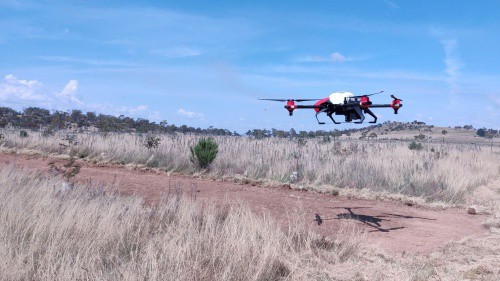Agricultural drone maker XAG has recently partnered with Australian charity Upper Snowy Landcare on a programme aimed at controlling the spread of the invasive African Lovegrass (ALG).
A fleet of XAG agricultural drones have been deployed to provide innovative solution on spraying the weeds with better precision and seeding the ALG-infested pasture in inaccessible areas. The project uses autonomous robots to minimise the use of herbicide, as well as restoring a healthy landscape against the regrowth of ALG.
Since March this year, trials are conducted to examine the effectiveness of drones on precision spraying and revegetation under the land care programme.
"These trials demonstrate how drones can be used in difficult, inaccessible areas where traditional vehicles or helicopters are not suited," said Margaret Mckinnon, chair of Upper Snowy Network.
Previously, farmers heavily rely on boom sprayers to apply herbicides over a large area. This has led to chemical overuse and the development of herbicide-resistant weeds.
Three trial sites, heavily invaded by ALG, have been set up in the Monaro region of New South Wales, Australia. Drone pilots from XAG mapped the fields on the smartphone with a remote sensing drone to identify all patches of ALG. At the first site, XAG agricultural drones loaded with herbicides were used to selectively spray isolated patches of African Lovegrass. The second site were treated by drones spraying between rows of tree plantation to remove weeds that would otherwise compete for water and nutrients.
At the third site where ALG was mechanically scalped, drones fitted with a special broadcast attachment evenly spread native grass seeds and shrubs to revegetate the bare ground. This helps to establish healthy pastures and further suppress the regrowth of hardy weeds.
Using smart tech to beat invasive plants
Weed is the most economically destructive type of invasive species in Australia. It causes biodiversity loss, wreaks havoc on grain crops and poses major risks to food security. According to Australia's Department of Agriculture, Water and the Environment, the annual cost of weeds incurred by the agricultural industry is estimated at AU$4 billion.
Herbicide is the most commonly used effective way for controlling weeds. But the incident of spray drift, also referred to off-target hazard, could happen when applying chemicals onto the weeds. This would contaminate the neighbouring crops and put native plants and animals at risks of poison.
With new technologies such as autonomous drones and AI, the country enhances its capacity to manage weeds cheaper and more effectively. With the enforcement of Australian Weeds Strategy 2017-2027, it has become a strategic priority to seek for innovative solutions to reduce the detrimental impacts of weeds.
The selection of equipment matters when it comes to reducing spray drift. The autonomous drones developed by XAG has demonstrated its ability to follow predetermined flight route and precisely spray weeds on the target. Compared with ground vehicle and helicopter, drone is a much more lightweight, sophisticated type of robot for killing weeds without crops being damaged.
Drone could be a safe, cost-effective, and sustainable method of weed control to reduce the negative impacts of yield loss and land degradation.
In trials with ALG, XAG's agricultural drones carried a 16L liquid tank and flew very low to accurately spray the selected target area in appropriate dose. Only patches infested with lovegrass were sprayed to greatly cut down the use of herbicides. Outcomes would be measured in terms of ALG regrowth and vegetation recovery rates with on-ground surveys over the ensuing six months.
Since 2013, XAG has been promoting the use of drones in agriculture to help farmers manage their fields with less manual labour. Its Australian team has dived deep to test the accuracy of drones on spraying weeds, as the recklessness of using herbicides sprayed by a boom brings up national concerns.



